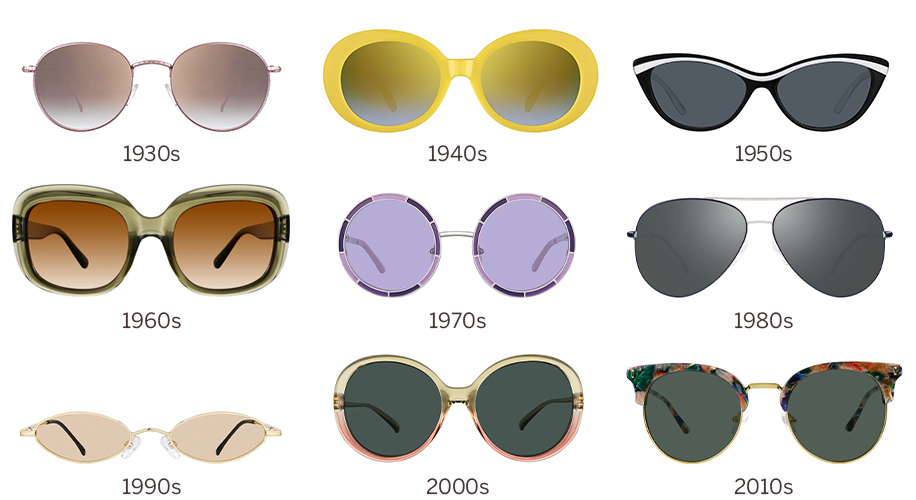The Rise of Sunglasses in the 20th Century
The modern concept of sunglasses began to take shape in the early 20th century. In the 1920s, sunglasses became popular in the United States, largely thanks to the movie industry. Hollywood stars were frequently seen wearing them, both on and off the screen, which helped to cement their status as a fashionable accessory. Sam Foster, founder of Foster Grant, was one of the pioneers in this field. In 1929, he began selling sunglasses on the beaches of Atlantic City, New Jersey, making them accessible to the public.
The 1930s saw further advancements with the introduction of polarized lenses by Edwin H. Land, who founded the Polaroid Corporation. These lenses significantly reduced glare by filtering out polarized light, which was particularly useful for outdoor activities and driving. During World War II, sunglasses were also issued to pilots to protect their eyes from the intense sunlight at high altitudes, leading to the development of the iconic aviator style.
Today, sunglasses are not only a fashion statement but also an essential tool for eye protection, reflecting their long and varied history. They have evolved from simple materials used by ancient civilizations to sophisticated accessories that combine style and function.
The Role of UV Protection in Sunglasses
Understanding UV Radiation and Eye Health
Ultraviolet (UV) radiation from the sun poses a significant risk to eye health. Prolonged exposure to UV rays can lead to several eye conditions, including cataracts, macular degeneration, and photokeratitis, also known as sunburn of the eye. Understanding these risks underscores the importance of wearing sunglasses that provide adequate UV protection.
Over time, exposure to these rays can damage the eyes and surrounding skin, emphasizing the need for protective eyewear.
Technological Advances in UV Protection
Technological advancements have significantly enhanced the UV protection offered by sunglasses. Modern lenses are often coated with special UV-blocking substances that can filter out up to 99-100% of harmful UVA and UVB rays. Polarized lenses, initially developed for reducing glare, now also incorporate UV protection, making them highly effective for outdoor activities such as driving, fishing, and skiing.
One of the notable innovations is the development of photochromic lenses, which automatically adjust their tint based on the intensity of UV light. These lenses darken in bright sunlight and lighten indoors, providing continuous protection without the need to switch eyewear.
Additionally, some high-performance sunglasses feature multi-layered coatings that combine UV protection with other benefits such as scratch resistance, anti-reflective coatings, and blue light filtering.
Introduction to Smart Sunglasses
As technology continues to advance, sunglasses have evolved beyond simple UV protection to become sophisticated smart sunglasses. These high-tech gadgets integrate various features that enhance functionality and connectivity, making them a valuable addition to modern eyewear collections.
Key Features of Modern Smart Sunglasses
Modern smart glasses come equipped with a range of innovative features. One of the most popular is audio integration, which allows users to listen to music, take phone calls, and receive notifications through built-in speakers or bone-conduction technology. This feature eliminates the need for separate headphones, providing a seamless and wire-free audio experience.
Another significant feature is the integration of heads-up displays (HUDs), which project information onto the lenses, allowing users to access data such as navigation directions, notifications, and fitness metrics without looking at their phones.
Connectivity is another key aspect of smart sunglasses. These devices can sync with smartphones and other smart devices via Bluetooth, enabling users to control various functions through voice commands or touch-sensitive controls on the frames. This connectivity makes smart glasses highly versatile, catering to various needs and preferences.
Popular Brands and Models
Several brands have emerged as leaders in the smart sunglasses market. Manha, known for its smart glasses, has introduced Manha Frames, which combine high-quality audio with stylish designs.
Amazon’s Echo Frames offer hands-free access to Alexa, providing a seamless way to manage tasks and access information on the go.
Another notable brand is Ray-Ban, which has partnered with Facebook to launch Ray-Ban Stories. These smart glasses feature built-in cameras for capturing photos and videos, as well as integrated speakers for audio playback. Ray-Ban’s collaboration with Facebook highlights the growing trend of merging fashion with cutting-edge technology.
These advancements in smart sunglasses demonstrate the potential for eyewear to become an integral part of our connected lives, offering convenience, functionality, and style in one package.
Applications and Benefits of Smart Sunglasses
Enhancing Outdoor Activities
Smart sunglasses offer numerous benefits for outdoor enthusiasts. For athletes and fitness enthusiasts, these gadgets can enhance performance by providing real-time data and metrics. For example, cyclists and runners can receive navigation prompts and performance stats, allowing them to stay focused on their activities without needing to check their devices.
For hikers and adventurers, smart sunglasses can provide valuable information about routes, weather conditions, and nearby points of interest. The integration of HUDs ensures that this information is always within the wearer’s line of sight, enhancing safety and convenience. Additionally, audio features allow users to enjoy music or podcasts while staying aware of their surroundings.
Smart Sunglasses in Everyday Life
In everyday life, smart sunglasses offer practical applications that enhance convenience and connectivity. Commuters can benefit from hands-free access to navigation, weather updates, and notifications, making their journeys smoother and more efficient. The ability to take calls and listen to audio content without removing the eyewear adds a layer of convenience for busy individuals.
For urban dwellers, smart sunglasses can provide real-time information about public transportation schedules, local events, and nearby services. This connectivity ensures that users are always informed and can make the most of their time and environment. The discreet design of many smart glasses models makes them suitable for various social and professional settings.
Health and Safety Benefits
Smart sunglasses also offer significant health and safety benefits. By integrating UV protection with advanced features, these devices reduce eye strain and prevent long-term damage from UV exposure. Some models also include blue light filtering, which helps protect the eyes from the harmful effects of prolonged screen time.
In terms of safety, smart glasses can provide real-time alerts and notifications, such as incoming messages or reminders, without requiring the user to look away from their current activity. This feature is particularly beneficial for drivers, cyclists, and pedestrians, as it allows them to stay connected without compromising their safety.
Future Trends in Sunglasses Technology
Innovations on the Horizon
The future of smart sunglasses promises even more exciting innovations. One anticipated advancement is the integration of augmented reality (AR) features, which will allow users to overlay digital information onto their real-world surroundings. This technology could revolutionize various fields, including navigation, education, and entertainment.
Biometric sensors are another potential addition to future smart glasses. These sensors could monitor vital signs, track physical activity, and even detect early signs of health issues. By providing real-time health data, smart sunglasses could become an essential tool for health-conscious individuals.
The Impact of AI and Machine Learning
Artificial intelligence (AI) and machine learning are expected to play a significant role in the evolution of smart sunglasses. AI can enhance the functionality of these devices by enabling them to learn user preferences and behaviors. For example, AI-powered smart glasses could provide personalized recommendations for routes, activities, and content based on the user’s habits and preferences.
Machine learning algorithms can also improve the accuracy and reliability of features such as voice recognition and gesture controls. As these technologies continue to advance, smart sunglasses will become even more intuitive and user-friendly, offering a seamless and personalized experience.
Sustainable and Eco-Friendly Sunglasses
Sustainability is becoming a crucial consideration in the development of smart sunglasses. Manufacturers are exploring the use of eco-friendly materials and production processes to reduce the environmental impact of these devices. This includes using recycled plastics, biodegradable materials, and energy-efficient technologies.
Consumers are increasingly demanding products that align with their environmental values, and the smart glasses industry is responding by prioritizing sustainability. This trend is likely to continue, leading to the development of smart sunglasses that are not only technologically advanced but also environmentally responsible.



